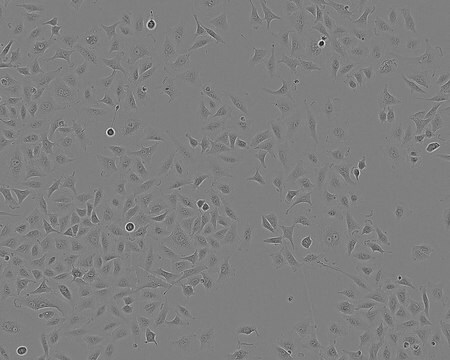DMS 79
95062824, human lung, Irregular
Se connecterpour consulter vos tarifs contractuels et ceux de votre entreprise/organisme
About This Item
Code UNSPSC :
41106514
Produits recommandés
product name
DMS 79, 95062824
Source biologique
human lung
Mode de croissance
Aggregates in suspension
Caryotype
Aneuploid
Morphologie
Irregular
Produits
Not specified
Récepteurs
Not specified
Technique(s)
cell culture | mammalian: suitable
Maladie(s) pertinente(s)
cancer
Conditions d'expédition
dry ice
Température de stockage
−196°C
Origine de la lignée cellulaire
Human lung small cell carcinoma
Description de la lignée cellulaire
DMS79 has been established from pleural fluid of a patient with small cell carcinoma of the lung. The patient was treated with cytoxan, vincristine, methotrexate and radiation therapy. The cultures show a tendency for the modal chromosome number to decline. The production of adrenocorticotropin (ACTH), bombesin, calcitonin, β-endorphin, 17-β-estradiol, lipotropin, ocytocin-neurophysin, parathyroid hormone and somatstatin-like imuno-reactivity has been reported. The cells have also been reported to have the following cell surface antigens: Leu-7, Class I HLA, Class II HLA, Mg23 defined by the AML-2-23 monoclonal antibody and the AML-1-99 defined antigen. The cells have a receptor for epidermal growth factor (EGF) and produce tumours in nude athymic mice. Cells grow as irregularly shaped aggregates.
Application
Human lung tumour model, carcinogenesis studies.
Milieu de culture
RPMI 1640 + 2mM Glutamine + 10% Foetal Bovine Serum (FBS) (Heat Inactivated).
Procédure de repiquage
Maintain cultures between 3 ? 9 x 100,000 cells/ml; 5% CO2; 37°C. Only dilute 1:2 as a maximum. This cell line grows as clumps in suspension which can be easily dispersed with pipetting. Trypsinisation is not necessary. Routine splitting can therefore
Autres remarques
Additional freight & handling charges may be applicable for Asia-Pacific shipments. Please check with your local Customer Service representative for more information.
Certificats d'analyse (COA)
Recherchez un Certificats d'analyse (COA) en saisissant le numéro de lot du produit. Les numéros de lot figurent sur l'étiquette du produit après les mots "Lot" ou "Batch".
Déjà en possession de ce produit ?
Retrouvez la documentation relative aux produits que vous avez récemment achetés dans la Bibliothèque de documents.
Notre équipe de scientifiques dispose d'une expérience dans tous les secteurs de la recherche, notamment en sciences de la vie, science des matériaux, synthèse chimique, chromatographie, analyse et dans de nombreux autres domaines..
Contacter notre Service technique

